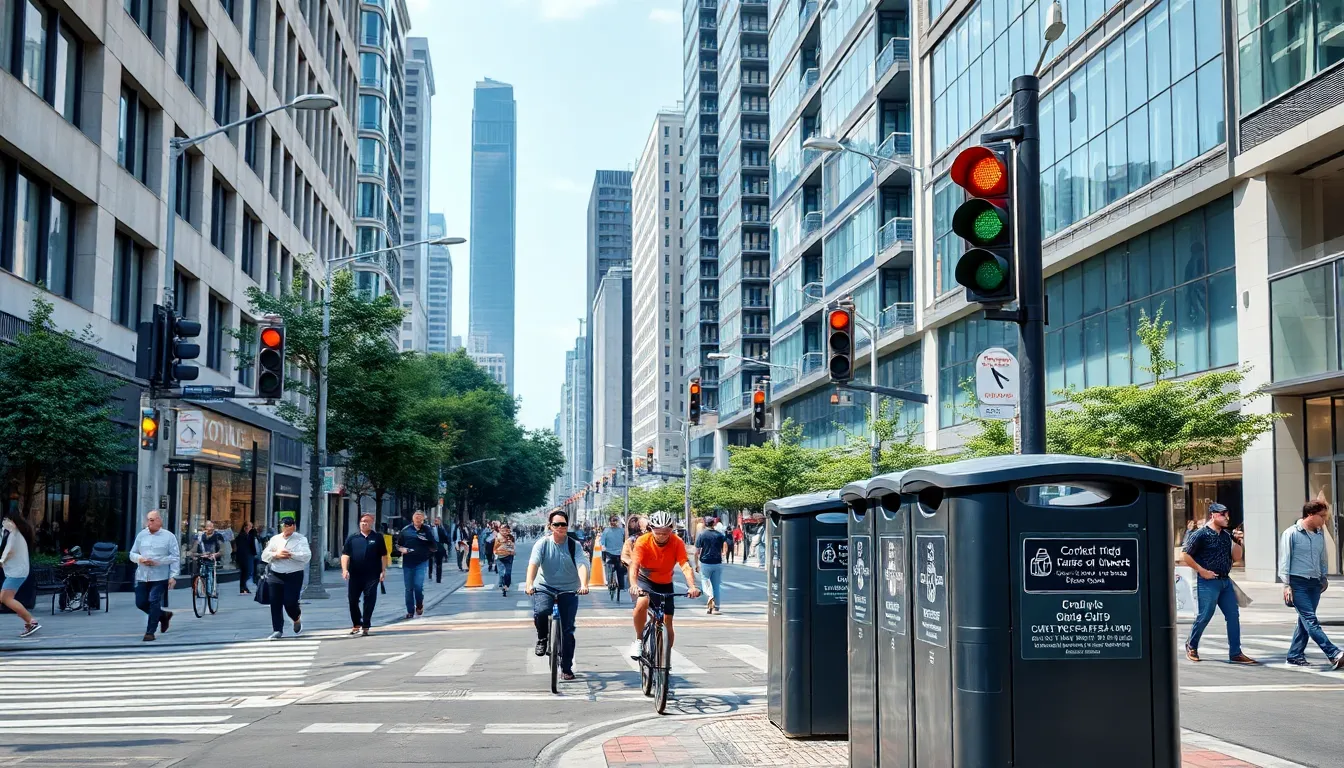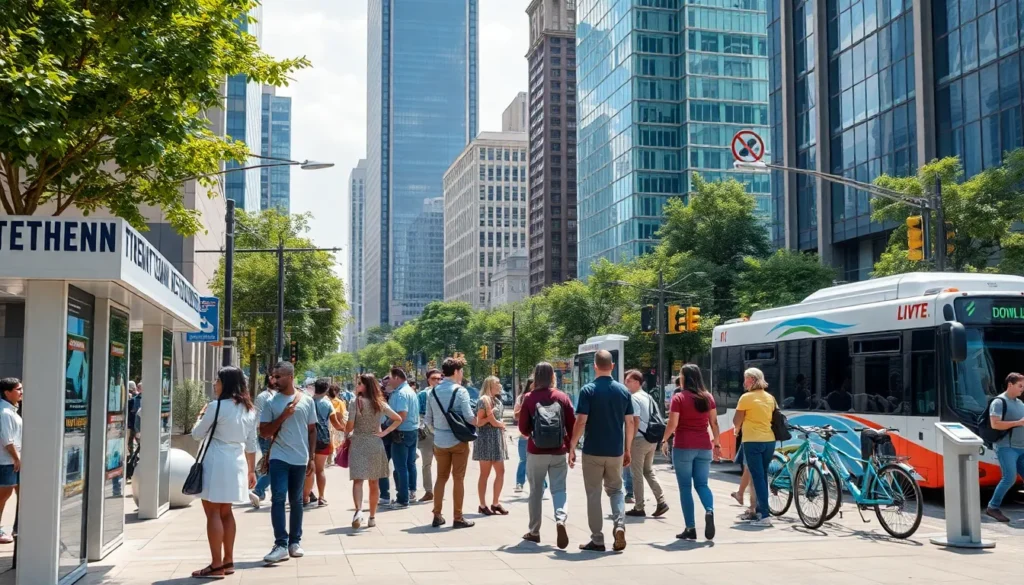Table of Contents
ToggleIn an era where urbanization is rapidly reshaping our world, smart city technology emerges as a beacon of innovation. These advancements harness the power of data, connectivity, and automation to enhance the quality of life for residents while promoting sustainability and efficiency. From intelligent transportation systems to energy-efficient buildings, smart cities are redefining how communities operate.
As cities grapple with challenges like congestion, pollution, and resource management, smart technologies offer transformative solutions. By integrating sensors and IoT devices, cities can optimize services and create a more responsive environment. The future of urban living lies in these smart innovations, paving the way for a more connected and sustainable world.
Overview of Smart City Technology
Smart city technology refers to the integration of data, connectivity, and automation to enhance urban living. These innovations tackle challenges associated with urbanization, promoting sustainability and improving the overall quality of life for residents.
Definition and Scope
Smart cities leverage technologies like the Internet of Things (IoT), big data, and artificial intelligence to streamline urban operations. They encompass various domains, including transportation, energy, water management, waste management, and public safety. The scope of smart city technology extends to improving infrastructure efficiency, enhancing public services, and fostering citizen engagement.
Importance of Smart Cities
Smart cities play a critical role in addressing urban challenges. They help reduce traffic congestion through intelligent transportation systems, minimize energy consumption with energy-efficient buildings, and lower pollution levels by optimizing resource use. Implementing smart city technology improves economic growth, enhances public safety, and fosters social inclusion. As more cities embrace these technologies, they create more resilient and adaptable urban environments.
Key Components of Smart City Technology

Smart city technology relies on several key components that integrate to enhance urban living and address various challenges. These components include the Internet of Things (IoT) and data analytics and management, which work together to optimize services and improve residents’ quality of life.
Internet of Things (IoT)
IoT serves as the backbone of smart city technology, consisting of interconnected devices that collect and exchange data. Sensors placed throughout urban areas monitor traffic patterns, air quality, and energy usage. For example, smart traffic lights adapt to real-time traffic conditions, reducing congestion. Additionally, smart waste bins signal when they’re full, optimizing waste collection routes. By leveraging IoT, cities promote efficiency and sustainability while ensuring residents receive timely information about their environment.
Data Analytics and Management
Data analytics and management are crucial for processing the vast amounts of information generated by IoT devices. Advanced data analytics tools analyze patterns and trends, enabling cities to make informed decisions. For instance, predictive analytics forecasts energy demand, allowing utility companies to optimize resource allocation. Efficient data management systems ensure that data remains secure and accessible, supporting decision-makers in implementing policies and services tailored to meet community needs. With effective data strategies, smart cities can enhance public safety, streamline operations, and improve overall quality of life.
Benefits of Smart City Technology
Smart city technology provides numerous advantages that transform urban living. Key benefits include enhancing urban mobility and improving sustainability, contributing to a higher quality of life for residents.
Enhancing Urban Mobility
Smart city technology enhances urban mobility through intelligent transportation systems. By leveraging real-time data, cities can optimize traffic flow and reduce congestion. Smart traffic signals adjust based on current traffic conditions, minimizing wait times. Connected vehicles communicate with infrastructure, enhancing safety and efficiency. Public transportation systems, equipped with GPS and mobile applications, provide real-time updates, improving user experience and increasing ridership. Consequently, integration of these technologies leads to reduced travel times and improved accessibility for all residents.
Improving Sustainability
Smart city technology improves sustainability by minimizing resource consumption and promoting eco-friendly practices. Advanced energy management systems monitor and distribute energy effectively, lowering consumption. Smart grids enable the integration of renewable energy sources, reducing dependency on nonrenewable options. Additionally, IoT-enabled waste management systems optimize collection routes, reducing emissions from garbage trucks. Water management technologies detect leaks and optimize usage, conserving vital resources. By adopting these technologies, cities foster a sustainable environment, decreasing carbon footprints while promoting a healthier urban ecosystem.
Challenges and Considerations
Smart city technology faces several challenges and considerations that can impact its successful implementation. These concerns primarily revolve around privacy, security, infrastructure, and costs.
Privacy and Security Concerns
Privacy and security issues emerge as significant challenges in smart city technology. Data collection from numerous IoT devices raises concerns about how personal information is stored and used. For instance, surveillance cameras and sensors monitor public spaces, prompting debates over the balance between safety and individual privacy. Ensuring robust security measures against cyber threats poses another challenge. Smart cities require encrypted communication and secure data storage to protect against unauthorized access. According to studies, approximately 43% of data breaches target small businesses, highlighting the need for comprehensive cybersecurity strategies.
Infrastructure and Cost Barriers
Infrastructure and cost barriers can hinder the successful deployment of smart city technologies. Existing urban infrastructure often requires significant upgrades to accommodate new technologies. For example, older electrical grids need modernization to support smart energy solutions. Additionally, the initial investment for smart city projects can be substantial. Reports indicate that smart city initiatives could cost cities billions of dollars, necessitating collaboration between public and private sectors for funding. Budget constraints can limit the scope and speed of implementation, making it essential for city planners to prioritize projects with immediate benefits.
Future Trends in Smart City Technology
Emerging trends in smart city technology highlight advancements that enhance urban living while addressing contemporary challenges. Key areas of focus include artificial intelligence integration and fostering community engagement.
Artificial Intelligence Integration
Artificial intelligence (AI) plays a pivotal role in smart city technology, streamlining urban services through enhanced data analysis and decision-making. AI algorithms process vast amounts of data from IoT devices, improving transportation systems by predicting traffic patterns and optimizing public transit schedules. AI-driven predictive maintenance can also ensure infrastructure remains safe and efficient, reducing downtime and operational costs. For instance, smart cameras can analyze pedestrian flow, adjusting traffic signals accordingly to improve safety. Integrating AI in energy management allows for real-time adjustments in consumption, further promoting sustainability.
Community Engagement and Participation
Community engagement is essential for the successful implementation of smart city initiatives. Cities increasingly leverage digital platforms to involve residents in urban planning and decision-making processes. Tools like mobile apps enable citizens to report issues such as potholes or malfunctioning streetlights swiftly. Engaging residents through surveys and social media provides valuable feedback, ensuring that smart city solutions meet the community’s specific needs. Cities that prioritize participation cultivate a sense of ownership among residents, leading to stronger support for policies. Examples include participatory budgeting initiatives, where communities allocate funds to local projects, enhancing transparency and civic involvement.
Smart city technology represents a transformative shift in urban living. By harnessing data and connectivity, cities can address pressing challenges while enhancing the quality of life for their residents. The integration of IoT and AI not only streamlines services but also fosters a sustainable environment.
As cities continue to evolve, the collaboration between public and private sectors will be crucial in overcoming obstacles. Engaging communities in the development process ensures that innovations meet the needs of all citizens. With these advancements, the future of urban living looks promising, paving the way for smarter, more resilient cities.





